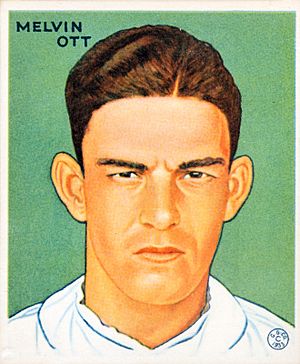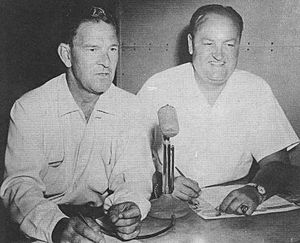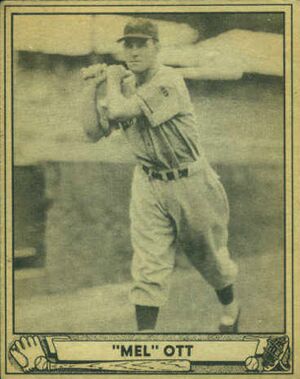Mel Ott facts for kids
Quick facts for kids Mel Ott |
|||
|---|---|---|---|
 |
|||
| Right fielder / Manager | |||
| Born: March 2, 1909 Gretna, Louisiana, U.S. |
|||
| Died: November 21, 1958 (aged 49) New Orleans, Louisiana, U.S. |
|||
|
|||
| debut | |||
| April 27, 1926, for the New York Giants | |||
| Last appearance | |||
| July 11, 1947, for the New York Giants | |||
| MLB statistics | |||
| Batting average | .304 | ||
| Hits | 2,876 | ||
| Home runs | 511 | ||
| Runs batted in | 1,860 | ||
| Managerial record | 464–530 | ||
| Winning % | .467 | ||
| Teams | |||
|
|||
| Career highlights and awards | |||
|
|||
| Induction | 1951 | ||
| Vote | 87.2% (third ballot) | ||
Melvin Thomas Ott (born March 2, 1909 – died November 21, 1958) was a famous American baseball player. People called him "Master Melvin." He played as a right fielder for the New York Giants in Major League Baseball (MLB) from 1926 to 1947.
Mel Ott batted left-handed and threw right-handed. Even though he was not very tall for a power hitter (about 5 feet 9 inches and 170 pounds), he was amazing. He led the National League in home runs a record six times. He was chosen as an All-Star for 11 years in a row. He was also the first player in the National League to hit more than 500 career home runs.
Mel Ott was voted into the National Baseball Hall of Fame in 1951.
Contents
Mel Ott's Early Life and Baseball Start
Mel Ott was born in Gretna, Louisiana, which is a town near New Orleans. From a young age, he was a great athlete, especially in baseball. While still in high school, he played on a semi-professional team several times a week. He showed incredible power when hitting the ball, even as a teenager. He even earned money for playing baseball when he was only 14 years old!
Mel Ott's Amazing Playing Career
Even with his strong hitting, Mel Ott's local minor league team, the New Orleans Pelicans, did not want to sign him. They worried he was too small. So, he found a job at a lumber company. There, he became a star on the company's baseball team. The company owner, Henry Williams, was very impressed with Ott.
When Williams visited New York, he told the Giants' manager, John McGraw, about Ott. McGraw decided to give him a tryout. Ott was not sure at first, but Williams bought him a train ticket to New York.
Ott arrived in New York in early September. He quickly impressed everyone with his hitting skills. Manager McGraw believed he would be "one of the greatest lefthand hitters the National League has ever seen." Ott officially signed a contract in January 1926.
Becoming a Star Player
Mel Ott started as a catcher, but Manager McGraw thought he was too small for that position in the major leagues. So, he changed Ott into an outfielder. After playing part-time for two years, Ott became the main right fielder in 1929 when he was just 20 years old. He did not disappoint! He hit 42 home runs and had 151 RBIs. Both of these were records for players aged 20 or younger.
Ott led the National League in home runs six times: in 1932, 1934, 1936, 1937, 1938, and 1942. From 1928 to 1945, he led the New York Giants in home runs every single year. This streak of 18 seasons is a record! No other player has led their team in home runs for so many years in a row. He was the youngest player to hit 100 home runs. He was also the first National League player to reach 500 home runs.
Ott was also known for getting many walks. He walked five times in a single game three different times. He set a National League record by getting six walks in a doubleheader twice. He also tied an MLB record by getting a walk in seven straight times at bat. He led the National League in walks six times.
He scored six runs in a game twice. Ott is the youngest major league player ever to hit for the cycle. This means he hit a single, double, triple, and home run all in the same game! He was also the first National League player to have eight seasons in a row with 100 or more RBIs. Only a few other great players have done this since.
Mel Ott's Unique Batting Style
Mel Ott had a special way of batting that was unusual at the time. He would lift his front (right) foot before hitting the ball. Manager McGraw called it "the most natural swing I've seen in years." This style helped him hit with a lot of power. Some later players, like Harold Baines and Kirby Puckett, used a similar style. Even the Japanese home run king, Sadaharu Oh, used a similar technique.
In 1943, all 18 of his home runs were hit in his home stadium, the Polo Grounds. The Polo Grounds had a very short foul line (about 257 feet) in right field. This made it easier to hit home runs there. Some sportswriters joked that he was the master of the "Chinese home run," which was a name for short home runs. Ott would often say that if it was so easy, other hitters should do it too!
However, the Polo Grounds also had the deepest "power alleys" in baseball. This made it harder to hit balls into those areas. Also, Ott hit more career home runs in other stadiums than any other National League hitter when he retired. In some of his best seasons, he even hit more home runs away from home than at the Polo Grounds.
Some people believe Ott was an even better hitter than his records show. This is because the baseballs used in the National League and American League were different back then. These differences made it much harder for National League hitters to hit home runs.
Ott was also a very good fielder. He was skilled at playing balls that bounced off the fences at the Polo Grounds. In 1929, his first full season, he had 26 assists. This means he helped get 26 runners out from the outfield. Baserunners quickly learned it was too risky to run when the ball was hit toward Ott!
World Series Appearances
Mel Ott played in the World Series in 1933, 1936, and 1937. He won the World Series with the Giants in 1933. In that series, he hit two home runs. In Game 1, he had four hits, including a two-run home run. In Game 5, he hit a home run in the 10th inning that won the series! In all his World Series games, Ott batted .295 with four home runs and ten RBIs.
Career Stats and Achievements
In his 22 years playing baseball, Mel Ott had a batting average of .304. He hit 511 home runs, had 1,860 RBIs, and scored 1,859 runs. He also had 2,876 hits, 488 doubles, and 72 triples. He was a great player who hit over .300 ten times in his career. When he retired, he had hit 200 more home runs than any other National League player at that time.
Mel Ott as a Manager
After his teammate Bill Terry retired as manager in 1941, Mel Ott took over as player-manager. This meant he was both a player and the team's manager. He continued to play regularly for five more years and was still a good hitter. In 1942, he led the league in home runs, runs scored, and walks.
In 1946, he hurt his knee while trying to catch a fly ball. This injury mostly ended his playing career. He played only a few more games in 1946 and retired as a player in 1947. He stayed on as manager until Leo Durocher took over in 1948.
The Giants' best finish under Ott was third place in 1942. His teams in 1943 and 1944 were affected by World War II, as many good players joined the military.
After managing the Giants, Ott helped his former teammate Carl Hubbell run the Giants' minor league system. Later, in 1951, Ott became the manager of the Oakland Oaks team in the Pacific Coast League.
Baseball Honors and Legacy
 |
|
| Mel Ott's number 4 was retired by the New York Giants in 1949. |
Mel Ott was elected to the Baseball Hall of Fame in 1951. His jersey number, "4," was also retired by the Giants in 1949. You can see his number displayed at Oracle Park, the Giants' home stadium.
He was chosen as a National League All-Star for 11 years in a row, from 1934 to 1944. He is one of only six National League players to play for the same team for more than 20 years.
Mel Ott was also nominated for the Major League Baseball All-Century Team, which honors the best players of the 20th century.
Broadcasting Career

After his playing and managing career, Mel Ott took a break from baseball in 1953 and 1954. In 1955, he joined the Mutual radio network to talk about baseball games. From 1956 to 1958, Ott worked with Van Patrick to broadcast games for the Detroit Tigers on both radio and television.
Mel Ott's Death
In November 1958, Mel Ott was in a car accident in Bay Saint Louis, Mississippi. He was taken to a hospital in New Orleans, where he sadly died a week later at age 49. He was buried in Metairie Cemetery.
Mel Ott's Lasting Legacy
Mel Ott is still remembered in his hometown of Gretna, where a park is named after him. Since 1959, the National League has given the Mel Ott Award to the player who hits the most home runs each year.
In the 1989 movie Field of Dreams, Mel Ott was one of the famous baseball players who appeared in the cornfield. In 2006, the United States Postal Service honored Ott with a postage stamp. He was part of a group of four "Baseball Sluggers" stamps. The others were Mickey Mantle, Hank Greenberg, and Roy Campanella.
The U.S. Postal Service said these players were "powerful hitters who wowed fans with awesome and often record-breaking home runs." They also said these players "set impressive standards for subsequent generations." The Mel Ott Little League in Amherst, New York, started in 1959 and was named after him soon after he passed away.
Mel Ott's name often appears in crossword puzzles because it is short and has a unique letter combination.
He is also mentioned in a poem called "Line-Up for Yesterday" by Ogden Nash, which was published in 1949:
O is for Ott
Of the restless right foot.
When he leaned on the pellet,
The pellet stayed put.
Mel Ott's Baseball Records and Accomplishments
Home Run Records
- He led the National League in home runs six times (1932, 1934, 1936–1938, 1942).
- He was the youngest player to hit 100 and 200 home runs.
- He was the first National League player to reach 500 home runs.
- He passed Rogers Hornsby in 1937 to become the all-time National League home run leader. He held this record (with 511 home runs) until Willie Mays passed him in 1966.
- He holds the major league record for leading his team in home runs for 18 years in a row (1928–1945).
Walks Records
- He got five walks in a game three times.
- He got six walks in a doubleheader twice.
- He shares an MLB record by getting a walk in seven consecutive times at bat (June 16 to 18, 1943).
- He led the National League in walks six times (1929, 1931–1933, 1937, 1942).
Other Offensive Records
- He scored six runs in a game twice (August 4, 1934, and April 30, 1944).
- He hit for the cycle (May 16, 1929).
- He was the first National League player to have eight seasons in a row with 100 or more RBIs.
Defensive Records
- He led National League outfielders in double plays twice (1929 and 1935).
Overall Achievements
- He was an 11-time All-Star (1934–1944).
- In 1999, he was ranked number 42 on The Sporting News' list of the 100 Greatest Baseball Players. He was also nominated for the MLB All-Century Team.
- He is one of only six National League players to play more than 20 years with one team.
- He managed the New York Giants for seven seasons (1942–1948).
See also
 In Spanish: Mel Ott para niños
In Spanish: Mel Ott para niños
- List of baseball players who went directly to Major League Baseball
- List of Major League Baseball home run records
- 500 home run club
- List of Major League Baseball career home run leaders
- List of Major League Baseball career hits leaders
- List of Major League Baseball career runs batted in leaders
- List of Major League Baseball players to hit for the cycle
- List of Major League Baseball annual home run leaders
- List of Major League Baseball player-managers
- List of Major League Baseball players who spent their entire career with one franchise


